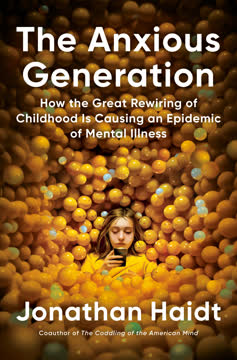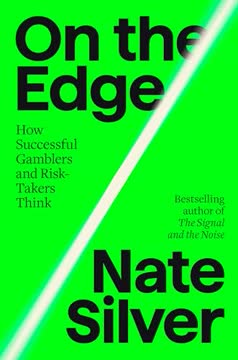가지 주요 요점
1. 오늘날의 청소년들은 디지털 시대에 전례 없는 도전에 직면해 있습니다
당신은 이런 청소년이 아니었습니다.
디지털 네이티브. 오늘날의 청소년들은 기술, 소셜 미디어, 그리고 끊임없는 연결이 가득한 세상에서 자라고 있습니다. 이 환경은 독특한 도전을 제시합니다:
- 정보 과부하와 조기 성인 콘텐츠 노출
- 여러 온라인 정체성을 유지해야 하는 압박
- 대면 사회적 상호작용 감소
- 사이버 괴롭힘과 온라인 괴롭힘에 대한 취약성 증가
기술 변화의 빠른 속도는 부모가 정보를 유지하고 적응하여 청소년을 효과적으로 이해하고 지원해야 함을 의미합니다.
2. 부모는 새로운 세대의 요구를 충족시키기 위해 접근 방식을 조정해야 합니다
우리는 매우 오래된 정보가 담긴 핸드북으로 양육하고 있습니다.
진화하는 양육 전략. 전통적인 양육 방법은 오늘날의 청소년들이 직면한 독특한 도전을 해결하는 데 효과적이지 않을 수 있습니다. 부모는 다음을 해야 합니다:
- 현재의 청소년 문화와 기술에 대해 교육받기
- 개방적이고 비판적이지 않은 의사소통 스타일 개발
- 경계를 설정하면서 독립성을 허용하는 균형 잡기
- 자신의 두려움과 편견을 인식하고 해결하기
접근 방식을 조정함으로써 부모는 청소년과 더 잘 연결되고 이 복잡한 발달 단계를 통해 그들을 안내할 수 있습니다.
3. 소셜 미디어는 청소년의 정체성과 자존감에 깊은 영향을 미칩니다
소셜 미디어는 청소년의 정체성과 자존감에 빠르게 통합되었습니다.
디지털 자아 이미지. 소셜 미디어 플랫폼은 청소년 생활의 중심이 되어 그들이 자신과 다른 사람들을 인식하는 방식에 크게 영향을 미칩니다:
- 큐레이션된 온라인 인물과의 끊임없는 비교
- 좋아요, 팔로워, 참여를 얻기 위한 압박
- 사이버 괴롭힘과 온라인 괴롭힘의 위험
- 건강하지 않은 신체 이미지와 자존감 문제의 잠재성
부모는 소셜 미디어 사용에 대해 열린 토론을 하고, 청소년이 건강한 온라인 습관을 개발하도록 돕고, 오프라인 활동과 관계를 장려해야 합니다.
4. 청소년 사이에서 불안과 정신 건강 문제가 증가하고 있습니다
오늘날의 아이들은 많은 것에 대해 존재론적으로 불안해합니다.
정신 건강 위기. 오늘날의 청소년들은 전례 없는 수준의 불안, 우울증 및 기타 정신 건강 문제를 경험하고 있습니다:
- 학업 압박과 미래의 불확실성
- 소셜 미디어로 인한 스트레스와 FOMO(놓칠 것에 대한 두려움)
- 글로벌 문제 인식(기후 변화, 정치 등)
- 정신 건강 증상의 조기 발현
부모는 정신 건강 인식을 우선시하고, 감정에 대해 열린 대화를 장려하며, 필요할 때 전문적인 도움을 구해야 합니다. 지지적인 가정 환경을 조성하고 스트레스 관리 기술을 가르치는 것이 중요합니다.
5. 물질 사용 패턴이 진화하여 새로운 부모 전략이 필요합니다
대마초는 위험합니다, 끝.
새로운 약물 환경. 청소년을 위한 물질 사용 환경이 크게 변화했습니다:
- 베이핑과 전자담배의 접근성 증가
- 대마초 사용에 대한 태도 변화
- 처방약 남용과 오피오이드 위기
- 진화하는 파티 문화와 "훅업" 장면
부모는 현재의 약물 동향에 대해 정보를 유지하고, 물질 사용 위험에 대해 솔직한 대화를 나누며, 책임 있는 행동을 모델링해야 합니다. 명확한 경계와 결과를 설정하면서 열린 의사소통을 유지하는 것이 필수적입니다.
6. 민감한 주제를 탐색하기 위해서는 열린 의사소통이 중요합니다
우리는 자살과 자살 생각에 대해 아이들과 이야기해야 하며, 이 주제에 대해 불편함을 느끼더라도 아이들이 언제든지 이야기하고 싶어 할 때 완전히 개방적으로 대해야 합니다.
어려운 대화. 부모는 청소년과 성, 관계, 정신 건강, 자살, 물질 사용 및 중독, 정체성과 성적 지향 등 도전적인 주제에 대해 논의할 준비가 되어 있어야 합니다.
이러한 대화를 위한 안전하고 비판적이지 않은 공간을 조성하면 청소년이 부모에게서 지침과 지원을 구하는 데 편안함을 느낄 수 있습니다. 정기적인 체크인과 적극적인 경청이 열린 의사소통을 유지하는 열쇠입니다.
7. 긍정적인 가정 환경 조성은 청소년의 웰빙을 지원합니다
집을 안식처로 만드세요.
안전한 피난처. 지지적인 가정 환경은 청소년의 정신 건강과 발달에 중요합니다:
- 일관된 일과와 기대를 설정하기
- 가족 연결과 개인 프라이버시를 위한 공간 만들기
- 열린 의사소통과 감정 표현을 장려하기
- 건강한 대처 전략과 자기 관리 모델링
가정에서 긍정적인 분위기를 조성함으로써 부모는 청소년이 청소년기의 도전을 헤쳐 나갈 수 있는 안정적인 기반을 제공합니다.
8. 회복력과 능력을 키우는 것이 주요 양육 목표입니다
양육의 목표는 능력과 회복력입니다.
생활 기술 개발. 부모는 청소년이 다음을 구축하도록 돕는 데 중점을 두어야 합니다:
- 문제 해결 능력
- 감정 조절 기술
- 사회적 능력
- 자기 주장
적절한 지원을 통해 청소년이 도전에 직면하고 극복하도록 허용하면 성인이 되는 데 필요한 회복력과 능력을 개발할 수 있습니다. 독립성을 장려하면서 안전망을 제공하십시오.
9. 보호와 현실 세계 노출의 균형이 필수적입니다
우리는 이 엄마가 제안하는 방법론을 따르면서 한동안 아이들을 현실 세계로부터 안전하게 지킬 수 있을 것입니다. 하지만 결국 우리는 아이들이 세상에 노출되기를 원합니다.
통제된 위험 감수. 부모가 자녀를 보호하고 싶어 하는 것은 자연스러운 일이지만, 현실 세계의 도전에 대한 일부 노출은 성장에 필요합니다:
- 연령에 적합한 독립성과 의사 결정 허용
- 방과 후 활동과 아르바이트 참여 장려
- 시사 문제와 사회적 이슈 논의
- 건강한 위험 감수와 실패로부터 배우기 지원
보호와 노출 사이의 균형을 맞추면 청소년이 성인기를 성공적으로 탐색하는 데 필요한 기술을 개발할 수 있습니다.
10. 수면과 신체 활동은 청소년의 정신 건강에 필수적입니다
수면 부족은 하루 동안 회복력을 고갈시킬 수 있습니다.
건강한 습관. 충분한 수면과 규칙적인 신체 활동은 청소년의 웰빙에 필수적입니다:
수면:
- 일관된 수면 일정 설정
- 편안한 취침 루틴 만들기
- 취침 전 화면 시간 제한
- 침실에서 전자 기기 제거
신체 활동:
- 규칙적인 운동이나 스포츠 참여 장려
- 야외 활동과 자연 노출 촉진
- 가족으로서 활동적인 생활 방식 모델링
이러한 기본적인 건강 측면을 우선시하면 청소년의 정신적, 정서적 웰빙, 학업 성취도, 전반적인 회복력이 크게 향상될 수 있습니다.
마지막 업데이트 날짜:
FAQ
What's "Parenting the New Teen in the Age of Anxiety" about?
- Overview: The book is a comprehensive guide for parents navigating the challenges of raising teenagers in today's anxiety-driven world.
- Focus: It addresses the emotional, social, and technological stressors that impact adolescents, offering strategies to maintain a positive parent-child relationship.
- Author's Expertise: Dr. John Duffy, a clinical psychologist, draws from his extensive experience working with teens and families to provide practical advice.
- Structure: The book is divided into three parts: understanding the new teen, addressing specific issues, and equipping parents with tools to support their children.
Why should I read "Parenting the New Teen in the Age of Anxiety"?
- Understanding Teens: It offers insights into the unique challenges faced by today's teenagers, which differ significantly from previous generations.
- Practical Strategies: The book provides actionable advice for parents to help their children navigate anxiety, social media, and other modern stressors.
- Strengthening Relationships: It emphasizes the importance of maintaining a strong, empathetic connection with your child.
- Expert Guidance: Dr. Duffy's experience and expertise make the book a reliable resource for parents seeking to improve their parenting approach.
What are the key takeaways of "Parenting the New Teen in the Age of Anxiety"?
- New Teen Definition: Adolescence now starts earlier and lasts longer, requiring parents to adapt their understanding and approach.
- Communication is Crucial: Open, ongoing dialogue with your child is essential for addressing issues like anxiety, social media, and identity.
- Emotional Bank Account: Building a positive relationship with your child involves making regular "deposits" of love, support, and understanding.
- Parental Involvement: Parents need to be actively engaged in their child's world, including understanding their social media use and peer interactions.
How does Dr. John Duffy define the "New Teen"?
- Extended Adolescence: The teenage years now begin before age 13 and extend beyond age 19, influenced by social media and academic pressures.
- Identity Challenges: Teens today face complex identity issues due to the constant influx of information and social comparisons.
- Emotional Awareness: They are more aware of mental health issues and often experience heightened anxiety and depression.
- Parental Role: Parents must adapt to these changes by being more informed and supportive than ever before.
What is the "Emotional Bank Account" concept in the book?
- Relationship Metaphor: The Emotional Bank Account is a metaphor for the goodwill and trust built in a parent-child relationship.
- Deposits and Withdrawals: Positive interactions, like empathy and support, are deposits, while negative interactions, like judgment, are withdrawals.
- Balance Importance: A positive balance ensures effective communication and influence, while a negative balance leads to disconnection.
- Building the Account: Parents should focus on connecting with their child through shared activities and open conversations.
How does "Parenting the New Teen in the Age of Anxiety" address social media?
- Impact on Teens: Social media is a significant source of anxiety and self-esteem issues for teenagers.
- Parental Involvement: Parents should understand the platforms their children use and engage in discussions about online behavior.
- Balance and Boundaries: Encouraging a healthy balance between online and offline activities is crucial for mental well-being.
- Positive Use: The book suggests ways to use social media positively, such as fostering creativity and social connections.
What advice does Dr. John Duffy give for managing teen anxiety?
- Open Dialogue: Encourage your child to talk about their fears and anxieties without judgment.
- Balance and Routine: Help your child establish a balanced routine that includes physical activity and downtime.
- Model Calmness: Parents should model calm and rational behavior, especially in stressful situations.
- Professional Help: Seek professional help if anxiety becomes overwhelming or unmanageable for your child.
What are the best quotes from "Parenting the New Teen in the Age of Anxiety" and what do they mean?
- "Your child needs you. Now more than ever." This emphasizes the critical role parents play in supporting their children through modern challenges.
- "Talk to your children in an open and ongoing discussion, free of lectures." It highlights the importance of communication without judgment.
- "The Emotional Bank Account is flexible, pliable, and forgiving." This suggests that relationships can be repaired and strengthened with effort.
- "We are losing children in record numbers, either literally or figuratively." A call to action for parents to be proactive in addressing their child's mental health.
How does Dr. John Duffy suggest parents handle the topic of drugs and alcohol?
- Early Conversations: Start discussions about drugs and alcohol by age eight or nine, using age-appropriate language.
- Honest Dialogue: Be honest about the risks and your own experiences, fostering an open line of communication.
- Safety Focus: Emphasize safety and the importance of making informed decisions rather than forbidding use outright.
- Model Behavior: Parents should model responsible behavior regarding alcohol and drug use.
What role does empathy play in "Parenting the New Teen in the Age of Anxiety"?
- Understanding Perspective: Empathy involves understanding and validating your child's feelings and experiences.
- Building Connection: It strengthens the parent-child bond and fosters open communication.
- Modeling Empathy: Parents should model empathetic behavior in their interactions with others.
- Emotional Support: Empathy provides the emotional support teens need to navigate their complex world.
How does the book address the issue of identity traffic?
- Multiple Identities: Teens manage multiple identities across different social settings, leading to confusion and stress.
- Parental Support: Parents should help their children explore and understand their authentic selves.
- Open Questions: Encourage open-ended questions about identity to facilitate self-discovery.
- Judgment-Free Zone: Create a safe space for your child to express their true identity without fear of judgment.
What is Dr. John Duffy's perspective on the role of fathers in parenting?
- Increased Involvement: Fathers today are more involved in parenting than previous generations, but there's room for more engagement.
- Unique Influence: A father's voice and perspective are crucial in shaping a child's understanding of gender roles and relationships.
- Modeling Respect: Fathers should model respect and equality in their interactions with women.
- Emotional Availability: Being emotionally available and supportive is essential for a child's development and well-being.
리뷰
저서 불안의 시대에 새로운 십대를 양육하기는 디지털 시대에 십대를 양육하는 데 있어 실용적인 조언을 제공한다는 점에서 대체로 긍정적인 평가를 받고 있다. 독자들은 소셜 미디어와 불안과 같은 현대적 도전에 대한 통찰력을 높이 평가한다. 일부는 내용이 반복적이거나 일관성이 없다고 느끼는 반면, 다른 이들은 희망적인 어조와 개방적인 소통을 강조하는 점을 칭찬한다. 많은 부모들은 오늘날 십대들이 겪는 독특한 어려움에 대한 책의 관점에 공감한다. 비평가들은 책이 더 해결책 중심적이고 덜 경고적일 수 있다고 제안한다. 전반적으로 독자들은 이 책이 십대 자녀를 이해하고 소통하는 데 유용한 자료라고 생각한다.
Similar Books














